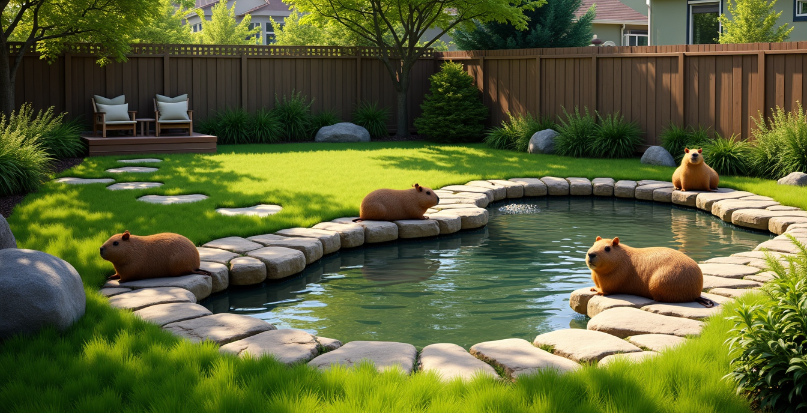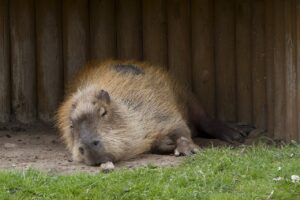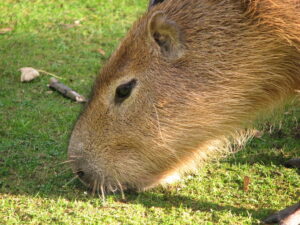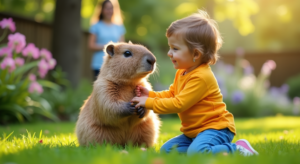Capybara care has gained popularity among exotic pet enthusiasts in recent years. These large rodents, native to South America, require specific habitat requirements to thrive in suburban backyards. Creating the right environment involves careful planning and consideration of factors such as space requirements, outdoor enclosures, and enrichment activities.
This guide explores how to create optimal conditions for capybaras in a suburban setting. It covers key aspects including designing multi-functional outdoor spaces, managing seasonal challenges, and integrating capybaras with other pets. Readers will learn about essential elements like mud wallows, grazing areas, shelters, and privacy considerations to ensure the well-being of these unique animals in captivity.
Understanding Capybara Behavior and Needs
Capybaras are highly social animals that thrive in group settings. In their natural habitat, these large rodents live in stable groups consisting of adult males and females, along with their young. The size of these groups can vary significantly, ranging from 6 to 16 adult members, depending on factors such as habitat characteristics and population density 1.
Social Requirements
To provide proper capybara care, it is essential to understand their social structure. A typical breeding group comprises one dominant male and 4-14 females. The dominance hierarchy among males is linear and remarkably stable, often lasting for years. The dominant male usually claims access to the best resources, including water holes and females in estrus 2.
In captivity, capybaras should never be housed alone, as this can lead to extreme stress and behavioral changes. Ideally, they should be kept in pairs or small groups to mimic their natural social structure. When designing an outdoor enclosure for capybaras, it’s crucial to provide enough space to accommodate their social needs and reduce potential aggression among group members.
Activity Patterns
Capybaras exhibit distinct daily activity patterns that should be considered when planning their care. They typically rest close together near water in the morning and spend the heat of the day in water or mud. Most of their grazing occurs in the late afternoon and evening, with short grazing sessions throughout the night 2.
To support these natural behaviors, a capybara care guide should emphasize the importance of providing a varied habitat. This includes access to water for swimming and thermoregulation, mud wallows for skin care and relaxation, and ample grazing areas. The outdoor enclosure should also offer shelter and shaded areas for resting during hot periods.
Stress Reduction
Minimizing stress is crucial for the well-being of capybaras in captivity. One effective way to reduce stress is through positive human-animal interactions. Keepers should strive to build trust with the capybaras under their care, as these animals can become quite responsive to gentle handling and even enjoy being petted 3.
Enrichment activities play a vital role in reducing stress and promoting natural behaviors. These can include providing various food items to encourage foraging, creating opportunities for play, and offering different textures and substrates for exploration. It’s also important to ensure that capybaras have access to private areas within their enclosure where they can retreat if they feel overwhelmed.
By understanding and catering to the behavioral needs of capybaras, caretakers can create an environment that promotes their physical and psychological well-being. This approach to capybara care not only ensures their health but also allows them to express their natural behaviors, leading to a more fulfilling life in captivity.
Designing a Multi-Functional Outdoor Space
Creating an optimal environment for capybaras in a suburban backyard requires careful consideration of their natural habitat and behavioral needs. A well-designed outdoor space should include various elements to support their physical and mental well-being.
Resting Areas
Capybaras need comfortable spaces to rest and relax. Providing shelter is crucial for their care, as it protects them from harsh weather conditions and offers a sense of security. A four-sided shelter is ideal, giving capybaras a safe retreat when they need it. The shelter should be spacious enough to accommodate the number of capybaras in the enclosure comfortably.
In addition to a main shelter, incorporating natural elements like trees and bushes can offer shade and additional resting spots. These features not only provide protection from the sun but also mimic the capybaras’ natural habitat, making them feel more at home.
Play Zones
Capybaras are social and playful animals, so creating engaging play zones is essential for their care. A large pond or pool is a must-have feature, as capybaras are semi-aquatic and love to swim. The water area should be easily accessible and large enough for them to swim freely and exercise 3.
Incorporating a mud wallow is another important aspect of capybara care. Mud wallows serve multiple purposes, including skin care, relaxation, and protection from parasites. This natural behavior is crucial for their well-being and should be encouraged in captivity 4.
To further enrich their environment, consider adding climbing structures and platforms at various heights. These elements can provide mental stimulation and physical exercise. Hanging platforms or hammocks can offer unique resting spots while encouraging capybaras to explore their surroundings 5.
Observation Points
Designing observation points within the enclosure allows capybaras to survey their surroundings, which is an important natural behavior. Elevated areas, such as small hills or raised platforms, can serve as vantage points for the capybaras to keep watch over their territory.
When creating observation points, it’s important to consider the capybaras’ need for privacy. Incorporate visual barriers and multiple hiding places throughout the enclosure. This gives the animals the choice to be seen or not, providing them with a sense of control over their environment 6.
To enhance the capybaras’ experience, consider integrating enrichment activities into these observation areas. For example, positioning branches of bamboo at different heights can encourage natural foraging behaviors and provide mental stimulation 7.
By designing a multi-functional outdoor space that includes resting areas, play zones, and observation points, you can create an environment that supports the physical and mental well-being of capybaras in captivity. This approach to capybara care ensures that these social and intelligent animals can express their natural behaviors and lead fulfilling lives in a suburban backyard setting.
Managing Seasonal Challenges
Capybara care requires special attention to seasonal changes, as these semi-aquatic mammals are native to warm climates. Proper management of their environment throughout the year is crucial for their well-being.
Winter Preparations
When temperatures drop, capybaras need extra protection. They can withstand outdoor temperatures as low as 4°C (40°F), but only with proper shelter and bedding 8. To ensure their comfort during colder months:
• Provide a heated shelter with ample bedding such as straw, hay, or mulch. • Install heating systems in indoor enclosures with backup power sources for emergencies. • Limit their exposure to snow, as capybaras are not well-equipped for frozen ground or slippery ice.
It’s important to note that young capybaras are particularly susceptible to cold weather. Even brief exposure to freezing temperatures can lead to health issues, as evidenced by cases of pneumonia in young capybaras after short periods in cold conditions 9.
Summer Heat Management
Capybaras thrive in warmer climates but still require protection from extreme heat. They can tolerate temperatures up to 32-38°C (90-100°F) with proper care 8. During hot weather:
• Ensure constant access to water for swimming and cooling off. • Provide ample shade through natural or artificial means. • Maintain mud wallows, which serve multiple purposes including thermoregulation.
Capybaras have underdeveloped sweat glands, making it difficult for them to cool down naturally 10. Their reliance on water for temperature regulation means that access to pools or ponds is crucial during hot periods.
Weather-Proofing
To create a year-round suitable environment for capybaras:
• Design multi-functional outdoor spaces that offer protection from various weather conditions. • Install proper drainage systems to prevent flooding during rainy seasons. • Use weather-resistant materials for enclosures and shelters.
For capybaras housed indoors, maintain humidity levels between 30-70% relative humidity (RH) 11. However, they can adapt to lower humidity levels in drier climates without apparent difficulty.
Seasonal challenges in capybara care extend beyond temperature control. Changes in daylight hours can affect their behavior and activity patterns. Providing a consistent 12-hour light and 12-hour dark cycle when housed indoors can help maintain their natural rhythms 12.
By addressing these seasonal challenges, caretakers can ensure that their capybaras remain comfortable and healthy throughout the year. Proper management of their environment not only supports their physical well-being but also allows them to express natural behaviors, contributing to overall capybara care and welfare.
Integrating Capybaras with Other Pets
Capybaras are known for their friendly and social nature, making them potentially compatible with other pets in a suburban backyard setting. However, proper integration requires careful planning and supervision to ensure the safety and well-being of all animals involved.
Safe Introductions
When introducing capybaras to other pets, it’s crucial to follow a gradual and controlled approach. Capybaras are highly social creatures that thrive in groups, so they may be receptive to interacting with other animals 13. To begin the introduction process:
• Start with supervised, short interactions in a neutral space. • Allow the animals to become familiar with each other’s scents before direct contact. • Observe body language closely for signs of stress or aggression.
It’s important to note that capybaras are naturally shy around humans and may take time to warm up to new companions 14. Patience is key during this process, as rushing introductions can lead to stress and potential conflicts.
Shared Spaces
Creating a harmonious environment for capybaras and other pets involves careful consideration of shared spaces. Capybaras require specific habitat features for their well-being, which should be taken into account when designing a multi-pet outdoor area:
• Provide ample space for all animals to move freely and avoid feeling crowded. • Ensure access to water for capybaras, as they need it for swimming and thermoregulation. • Create separate resting areas for each species to prevent territorial disputes.
When integrating capybaras with dogs, it’s essential to have sufficient space and appropriate shelter for both species 15. This helps minimize potential stressors and allows each animal to have its own territory within the shared environment.
Supervision Techniques
Ongoing supervision is crucial for maintaining positive relationships between capybaras and other pets. Some effective supervision techniques include:
• Monitoring all interactions closely, especially during the initial stages of integration. • Intervening promptly if signs of aggression or discomfort arise. • Gradually increasing the duration and frequency of interactions as trust builds between the animals.
It’s important to remember that capybaras are not aggressive by nature and can coexist peacefully with various species 16. Their calm demeanor and non-threatening body language often contribute to positive interactions with other animals.
When considering capybara care in a multi-pet household, it’s essential to provide enrichment activities that cater to each species’ needs. This can include puzzle feeders, interactive toys, and regular engaged companionship to keep their minds active and spirits high 13.
By following these guidelines and maintaining a watchful eye, it’s possible to create a harmonious environment where capybaras can thrive alongside other pets in a suburban backyard setting. Remember that each animal is unique, and the integration process may vary depending on individual personalities and circumstances.
Conclusion
Creating a suitable environment for capybaras in a suburban backyard requires careful planning and attention to detail. This guide has explored key aspects of capybara care, including understanding their social needs, designing multi-functional outdoor spaces, managing seasonal challenges, and integrating them with other pets. By addressing these factors, caretakers can ensure the well-being and happiness of these unique animals in captivity.
Ultimately, successful capybara care hinges on mimicking their natural habitat while adapting to the constraints of a suburban setting. This approach not only supports the physical health of capybaras but also allows them to express their natural behaviors. With proper care and attention, these social and intelligent creatures can thrive in a backyard environment, bringing joy and fascination to their caretakers while serving as ambassadors for their species.
FAQs
What type of habitat do capybaras prefer?
Capybaras thrive in semi-aquatic environments, often found in areas with dense vegetation near rivers, lakes, ponds, marshes, and swamps. They are mostly active in feeding during the afternoon and intermittently throughout the night, while mornings are typically reserved for dozing, often taking short naps during the day as others in their group remain vigilant.
What constitutes an ideal living environment for capybaras?
Naturally occurring in South America, capybaras are well-suited to forest, savannah, and marshland areas. They are adapted to aquatic life and are crepuscular, meaning they are most active during the twilight hours of dawn and dusk.
What climate conditions are optimal for capybaras?
Capybaras are best suited to rainforest climates where there are estuaries, marshes, rivers, and streams. Their natural habitat typically receives about 2.3 meters (7.5 feet) of rainfall annually, with a dry season from May to November and a flood season from December to April.
What type of shelter is necessary for capybaras?
Capybaras require enclosures that include grassy areas and a sizable pool for swimming. In some regions like Japan and America, they are often kept in smaller enclosures with a concrete or hard earth floor and a small water tub, which may sometimes be barely large enough for them to fit into.
References
[1] – https://www.researchgate.net/publication/259928340_Capybara_social_structure_and_dispersal_patterns_Variations_on_a_theme
[2] – https://ielc.libguides.com/sdzg/factsheets/capybaras/behavior
[3] – https://capybaraworld.wordpress.com/category/capybara-management-in-captivity/
[4] – https://capybaraworld.wordpress.com/category/capybara-enclosure-design/
[5] – https://ipwizard.online/the-latest-trend-in-outdoor-fun-creating-the-perfect-playground-for-your-pet-capybara/
[6] – https://wildwelfare.org/wp-content/uploads/Care-for-us-Capybara-1.pdf
[7] – https://capybaraworld.wordpress.com/2021/06/16/capybara-enclosure-design-husbandry-and-welfare-of-capybaras-in-zoos-and-captive-environments/
[8] – https://ambassadoranimalsag.wordpress.com/2019/07/04/capybara/
[9] – https://rousfoundation.com/2019/06/do-capybaras-like-snow/
[10] – https://study.com/academy/lesson/what-is-a-capybara-facts-adaptations-habitat.html
[11] – https://assets.speakcdn.com/assets/2332/capybara_care_manual_2021.pdf
[12] – https://petcapybara.com/wp-content/uploads/2013/04/capybara_husbandry.pdf
[13] – https://www.truthorfiction.com/capybaras-as-pets-a-comprehensive-guide/
[14] – https://www.thesprucepets.com/capybara-pet-4101211
[15] – https://www.capybaranation.com/post/do-capybaras-get-along-with-dogs-exploring-their-compatibility
[16] – https://www.quora.com/Why-are-capybaras-inoffensive-to-other-animals






